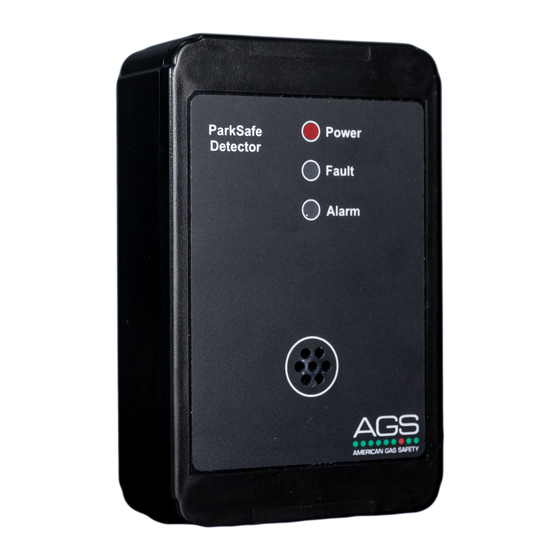AGS Parksafe Control Panel Kurulum, Çalıştırma ve Bakım Kılavuzu - Sayfa 14
Kontrolör AGS Parksafe Control Panel için çevrimiçi göz atın veya pdf Kurulum, Çalıştırma ve Bakım Kılavuzu indirin. AGS Parksafe Control Panel 20 sayfaları. Ventilation control panel
Ayrıca AGS Parksafe Control Panel için: Kurulum ve Kullanım Kılavuzu (16 sayfalar), Kurulum ve Kullanım Kılavuzu (16 sayfalar), Kurulum Operasyon ve Bakım (16 sayfalar)

Installation, Operation & Maintenance
Bump Testing (Gas Response Check)
All certified test gases supplied by AGS are classified as non-flammable and non-toxic, however, they may contain gas under
pressure and may explode if heated to extreme temperatures and cause asphyxiation in high concentrations. Always use in
accordance with the safety data sheet!
Gas response checks are often referred to as a 'bump test'. Bump tests are important to make sure a device
can detect a release of gas as early as possible. The aim of the bump test is to make sure a detector is working
at its optimum by briefly exposing the unit to a known concentration of the target gas that usually exceeds the
highest alarm point. If the detector goes into alarm and all signals/outputs activate, then the system is working.
If the system fails to operate as intended in an alarm state, the gas detector must not be used until a full
inspection and service has been conducted. NFPA requires all gas detectors to be tested annually and that the
test results be recorded on site and available to inspectors.
A detector may visually appear in good working order, but its sensitivity and accuracy can be inhibited by
external factors. Dust, humidity, temperature fluctuations, cleaning products, contaminants, exposure to its
target gas or sensor drift (ageing) can cause a decline in sensitivity, accuracy, and eventual failure.
Regular bump tests are important to make sure the detector can detect a release of gas as early as possible
and usually takes seconds (gas type dependant i.e., CO sensors will take over a minute) and is often
completed alongside a scheduled fire alarm test, however the frequency should be determined following an
appropriate risk assessment by the end user.
We recommend testing detectors every 12-18 months along with the regular fire test procedures and coincide
with the annual service message prompted on the detection system after each year of service/operation.
Contact your AGS representative for details of suitable bump testing kits and gases. Kits usually consist of a
certified gas cylinder or spray. We recommend only using AGS calibration gas kits to ensure correct flow rates
meet AGS technical requirements. A bump testing gas is usually a concentration mix that exceeds the highest
alarm set point.
Bump Test Procedure
Step 1 will enable service mode and inhibit all alarms/outputs and signals for fifteen (15) minutes!
If you are testing all actuation of alarms/outputs and signals, please proceed to Step 2!
The controller will return to a normal operational state after fifteen minutes automatically unless service mode is disabled
manually by pressing the [Exit] button on screen!
Always give at least five (5) minutes between testing the same unit or until gas has fully dispersed!
If Service mode is activated – reset the system after completing the bump tests!
Pressing silence on the controller will silence the internal buzzer when in alarm!
Step 1. Activate Service Mode
Access service mode by pressing the AGS logo on the controller (home screen logo only).
•
The screen will display a service message prompt.
•
Press Yes. (Note: All alarm signals/outputs will be inhibited for fifteen (15) minutes.
•
Proceed to test gas detectors.
•
Upon completion – exit service mode by pressing the 'Exit' button on screen.
•
Rev: 20
ParkSafe Controller
14
